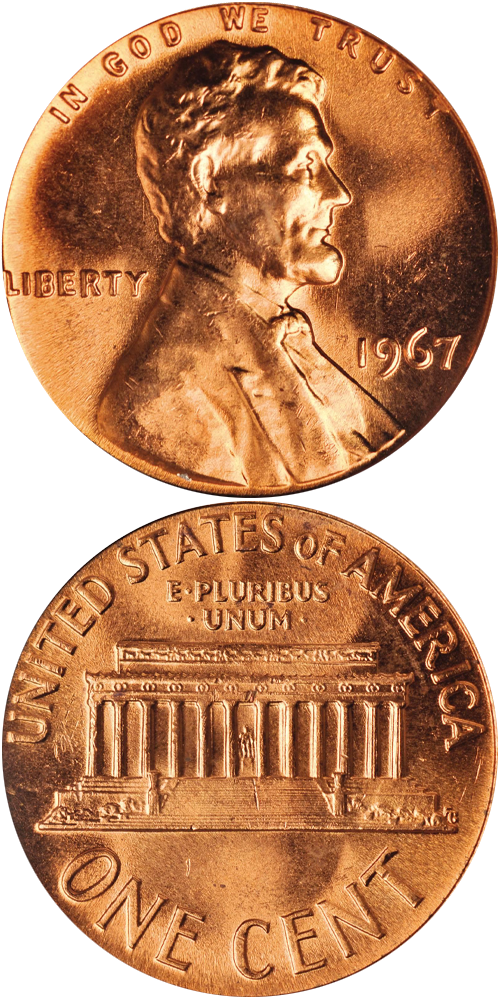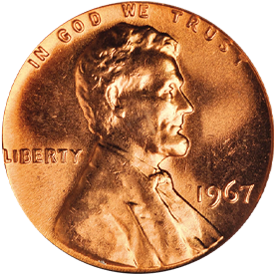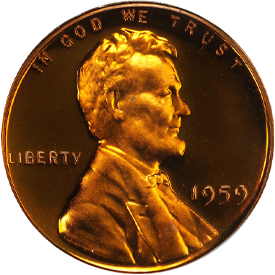Designed by: Victor D. Brenner (obverse) and Frank Gasparro (reverse)
Issue Dates: 1959-1982
Composition: 5% tin and zinc (1959-1962), 95% copper, 5% zinc (1962-1982)
Diameter: 19 mm
Weight: 3.11 grams (48 grains)
Edge: Plain
Business Strike Mintage: 158,150,469,776
Proof Mintage: 65,103,802
In 1959 the reverse of the Lincoln cent was restyled. The former wreath motif was discarded in favor of a plan view of the Lincoln Memorial, a design by Frank Gasparro of the United States Mint. Above the building the motto E PLURIBUS UNUM appears, while UNITED STATES OF AMERICA and ONE CENT are around the border. The obverse remains the same as used in earlier years. This style, made in ''bronze" from 1959 to 1962, had a composition of 0.95 part copper and 0.05 part tin and zinc. In 1962 the alloy was changed slightly to 0.95 part copper and 0.05 part zinc.
Lincoln cents of this style were made in large quantities, with numerous issues exceeding the billion mark. Although in an era in which the cent piece had virtually no purchasing power on its own, and in which logic would suggest that the denomination would be obsolete, the proliferation of state and local sales taxes made the cent more important than ever to facilitate making change. Thus, during this span cents were produced in record quantities, exceeding for the first time the ten billion mark in 1982.
Examples of the 1959-1982 cent are easily obtainable in any grade desired.
Further Reading
In 1958 the wreath device was discontinued. Toward the end of that year announcements were made in popular newspapers that a new motif would make its appearance in 1959. The news caught collectors by surprise. There had been no previous discussion in the Numismatic Scrapbook Magazine, Numismatic News, or The Numismatist, the three main collector publications.
In 1959 the Lincoln Memorial reverse motif made its debut as scheduled. It soon was speculated that the old wheat-type cents would have value, and before long countless American citizens were putting them away. Within 15 years later they were seldom seen in circulation.
The year 1960 saw the appearance of the 1960 (Philadelphia Mint) and 1960-D large and small date varieties. These caused a sensation and resulted in tremendous nationwide publicity being given to the coin hobby. Time magazine and countless newspapers told of mini-fortunes being made by people fortunate enough to acquire a $50 Mint-sewn bag of the small date variety. Instant sales were reported for many thousands of dollars per bag, with several in the $10,000 to $12,000 range! A barber in Binghamton, New York, and a bank teller in Syracuse in the same state were among the lucky ones, and there were many others as well. In Syracuse, dealer Jonah Shapiro made a lively market in the issue.
For a couple of years beginning in 1965 there was a nationwide shortage of one-cent pieces, as Lincoln cents became a popular speculation, and it didn't cost much to put away a bag or two. In an effort to curtail numismatic interest, Mint Director Eva Adams mandated that mintmarks be dropped, so issues made at the Denver Mint during 1965, 1966, and 1967 do not bear any designation. Actually, it was not numismatists who caused the coin shortage problem, it was the general public. Eva Adams made pronouncements against coin collectors, considering them to be the root of many of the Mint's distribution problems. Upon retirement, she did an about-face and became a familiar figure at coin conventions! Soon, her past statements were forgotten, and she was warmly welcomed to the hobby.
In 1972 a new Doubled Die obverse appeared on a Lincoln cent variety. While these were discovered shortly after issue, and while many thousands of Uncirculated pieces were identified and saved (in contrast with the 1955 Doubled Die cent of which only a few hundred strictly Uncirculated pieces were rescued), still they went on to be worth several hundred dollars apiece.
In 1982, bronze, which had been used to strike cents for circulation since 1864, was discontinued in favor of copper plated zinc. Again, the Lincoln cent made news in hobby publications.
Scarcely a year goes by without one government official or another declaring that high prices in the modern economy have rendered such a small coin as the Lincoln cent completely useless. But each year sees a seemingly larger number of such coins minted. This apparently contradictory situation is explained by the widespread sales taxes levied by various states. A $1 purchase might involve not only a dollar but 6c tax, for which Lincoln cents are required.
First minted in 1793, and faced with an uncertain life due to Mint problems at the outset, the cent denomination progressed through the years to reflect changing ideas of design, metallic composition, and, indeed, politics and national emergencies. The Civil War, with its bronze tokens inspiring a change of cent alloy, and World War II with its copper shortages dictating a change to zinc-coated steel, are part of the story, as is the 1909 commemoration of Lincoln's birth. On a narrower scale, but perhaps of more interest to numismatists, are the coins themselves – stories of the 1793 Chain, the 1794 Starred Reverse, the 1817 15-star variety, the 1856 flying eagle, the scarce-date 1877, the popular 1909-S V.D.B., Matte Proofs, the 1955 Doubled Die, and many others. Certainly, cents have a rich numismatic history. And, if history repeats itself, the coming years will bring even more interesting pieces in the series.








